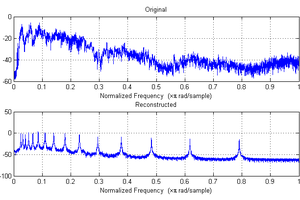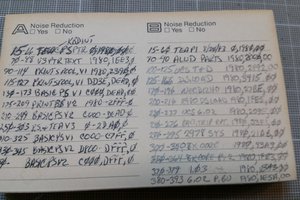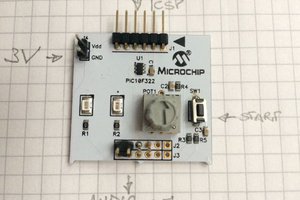DPCM (2-bit samples)
A version of the DPCM algorithm can be implemented using very little
processing time. A 2-bit/sample compressor/decompressor was written in
Matlab to encode and to make a packed C header file, and
then to do a test-decode. Note that the quantization break-points and reconstruction
values are made up by me. You can change them, but you must be consistent
in the encoder and decoder. An optimization (program
+ function) based on the histogram of first derivitives
suggests that quantization breakpoints of [-0.05, 0, 0.05] and
reconstruction values of [-0.16, -0.026, 0.026, 0.16] are about
right for demo wav file given below. A decoder written
in GCC for the Mega644 uses the packed code format to generate speech.
Each second of speech takes 2 kByte of flash.
To use this system:
- If you want to have the Mega644 just speak the numerical digits, skip this list and use the code in the next paragraph.
- Get some clean, noise-free speech. You could record your own voice or use this TextToSpeech demo.
- Make sure the audio sample rate is 8kHz and save it in a wav file. This little matlab program downsamples a wav file by 2:1. If you use the text-to-speech demo in step (2) you will need to downsample.
- Run the Matlab compressor on the wav file. The compressor output file will be a table in C header format. You could, of course, have several short compressed tables in flash, or you could index into a long table to say just one word.
- Resynthesize on Mega644.
- Include the compressor output file from step (4) in your c program.
- Attach PORTB.3 to a low pass filter, and then to an audio amplifier. The low pass should cutoff at about 18,000 radians/sec (3000 Hz). Sometimes you can skip the lowpass and use the input characteristics of the audio amp to lowpass.
The file <a href="http://people.ece.cornell.edu/land/courses/ece4760/Speech/GCC644/DPCMAllDigits.h">DPCMAllDigits.h</a> has a
GCC flash array for the digits zero to nine. If you include this in a test
program, you have available all the spoken digits. The sample index boundaries
for the digits in the array are given below. Using this table you can speak
individual digits by decompressing only part of the flash array.
<a href="http://people.ece.cornell.edu/land/courses/ece4760/Speech/GCC644/DPCMAllDigits.h">DPCMAllDigits.h</a> is based
on the TextToSpeech
demo page using the simulated voice "Claire". Commas were placed
between the digit names for synthesis. The original synthesis
result (wav at 16 Ksamples/sec) and reduced
rate result (wav at 8 Ksamples/sec) used as input to the compressor are
included for reference.
DPCM (1-bit samples)
A version of the encoder was written that simply sends one bit/sample depending on the sign of the first derivitive. The reconstructed speech has noticably higher noise than the 2-bit version, but is still understandable. The 8Ksample/sec speech waveform (from the TextToSpeech demo page using the simulated voice "Mike") is compressed with a matlab program to produce a C header file, which is included in a mega644 test program. About 60 seconds of speech should fit into flash on a mega644. Attach PORTB.3 to a low pass filter, and then to an audio amplifier. The low pass should cutoff at about 18,000 radians/sec (3000 Hz). Sometimes you can skip the lowpass and use the input characteristics of the audio amp to lowpass.
 Bruce Land
Bruce Land



 Denver
Denver

 lucio
lucio
I took your 1-bit compression and ran it through Audacity's noise reduction filter, and cranked the reduction up to 30 dB. This sounded pretty muddy, so I ran it through a high-pass filter at 3000 Hz with a 3 dB/octave slope, then normalized that. The result was a marked improvement over the original. It did have some artifacts that made it sound like it was on the verge of oscillating, but this was less objectionable than the noise.
Now, I don't know how sophisticated Audacity's noise reduction filter is, so I don't have any idea whether this is within the realm that an 8-bit AVR can handle, but the high-pass filter is pretty easy. Point is, you can sometimes get away with more compression if you can afford some additional processing power.